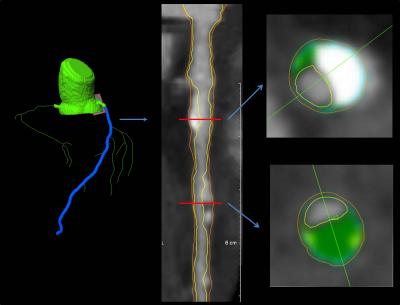CT angiography links arterial plaque with diabetes, blood pressure, cholesterol

These images are of a 62-year-old man. Left: coronary segmentation model of the coronary tree. Middle: a curved multiplanar reconstruction of the left anterior descending artery, with the lumen and external vessel walls marked. Right: representative cross-sectional images, with green shading is noncalcified plaque. Image courtesy of the Radiological Society of North America
Coronary artery disease (CAD) is the leading cause of death in men and women worldwide, accounting for 17 million deaths annually. Current treatment strategies focus on cardiovascular risk and serum cholesterol levels rather than direct assessment of extent of disease in the coronary arteries.
Plaque that forms in the arterial walls can restrict blood flow and, in some cases, rupture, leading to potentially fatal heart attacks. There is considerable evidence that calcified, or stable, plaque is less prone to rupture than non-calcified, or soft, plaque.
Intravascular ultrasound can quantify non-calcified and calcified coronary artery plaque, but it is invasive and unsuitable for screening purposes. Coronary artery calcium (CAC) scoring with CT, a common noninvasive option, measures how much calcified plaque a person has, but it doesn't measure non-calcified plaque, and that's the component that tends to be dangerous.
Despite treatment for hypercholesterolemia (high levels of cholesterol in the blood), CAC scores often paradoxically increase. Thus, researchers have searched for other plaque measures that can identify treatment response.
'Most information to date about coronary artery disease and cardiovascular risk factors in asymptomatic individuals has been derived from calcium scoring,' said the study's lead author, David A. Bluemke, M.D., Ph.D., from the NIH Clinical Center. 'We hypothesized that risk factors for the presence of non-calcified plaque may differ from those for calcified plaque.'
Coronary computed tomography angiography (CCTA) has emerged as a viable screening option for plaque, including non-calcified plaque. CCTA can capture the full anatomic map of the coronary arteries in a single heartbeat with low radiation dose and provide a complete picture of the total amount of plaque throughout the arteries of the heart.
For the study, Dr. Bluemke and colleagues used CCTA to assess the relationship between calcified and non-calcified coronary plaque burden in the coronary arteries and cardiovascular risk factors in low- to moderate-risk asymptomatic individuals.
The researchers recruited 202 asymptomatic men and women over age 55 who were eligible for statin therapy. CCTA was performed using a 320-detector row CT scanner and an intravenous contrast agent. Coronary wall thickness/plaque was evaluated, and analysis was performed to determine the relationship between risk factors and plaque.
Controlling for all risk factors, total coronary plaque index was greater in men than in women. Non-calcified plaque index was significantly associated with greater systolic blood pressure, diabetes, and elevated low-density lipoprotein (LDL) cholesterol level.
'These results highlight the potential of CCTA in quantifying plaque burden to assess progression or regression of coronary artery disease in low to moderate risk individuals,' Dr. Bluemke said.
###
'Coronary plaque burden at coronary CT angiography in asymptomatic men and women.' Collaborating with Dr. Bluemke were Karen Rodriguez, B.A., Alan C. Kwan, B.A., Shenghan Lai, M.D., João A. C. Lima, M.D., Davis Vigneault, B.S., Veit Sandfort, M.D., Puskar Pattanayak, M.D., Mark A. Ahlman, M.D., Marissa Mallek, R.N., and Christopher T. Sibley, M.D.
Radiology is edited by Herbert Y. Kressel, M.D., Harvard Medical School, Boston, Mass., and owned and published by the Radiological Society of North America, Inc.
RSNA is an association of more than 54,000 radiologists, radiation oncologists, medical physicists and related scientists promoting excellence in patient care and health care delivery through education, research and technologic innovation. The Society is based in Oak Brook, Ill. (RSNA.org).
For patient-friendly information on CCTA, visit Radiology Info.
Media Contact
All latest news from the category: Health and Medicine
This subject area encompasses research and studies in the field of human medicine.
Among the wide-ranging list of topics covered here are anesthesiology, anatomy, surgery, human genetics, hygiene and environmental medicine, internal medicine, neurology, pharmacology, physiology, urology and dental medicine.
Newest articles

Silicon Carbide Innovation Alliance to drive industrial-scale semiconductor work
Known for its ability to withstand extreme environments and high voltages, silicon carbide (SiC) is a semiconducting material made up of silicon and carbon atoms arranged into crystals that is…

New SPECT/CT technique shows impressive biomarker identification
…offers increased access for prostate cancer patients. A novel SPECT/CT acquisition method can accurately detect radiopharmaceutical biodistribution in a convenient manner for prostate cancer patients, opening the door for more…

How 3D printers can give robots a soft touch
Soft skin coverings and touch sensors have emerged as a promising feature for robots that are both safer and more intuitive for human interaction, but they are expensive and difficult…





















